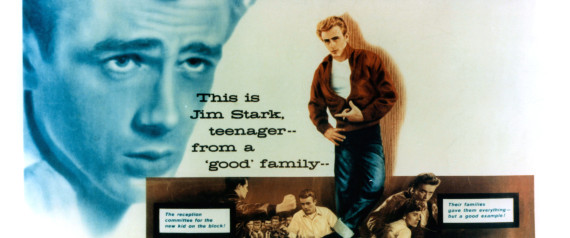'Rebel Without a Cause'
Posted: 11/01/2013 12:10 pm

So much has been said and written and expressed about James Dean in the 58 years since his death. So many tributes and memoirs, so many songs and plays and movies, so many posters fashioned from Dennis Stock's famous black and white photograph of Dean on Times Square. Over time, as those who knew him have died out along with the people who were so deeply affected by his pictures when they were first released, it has all started to harden into a distant legend.
And then, you go back and actually look at the pictures again, and you're confronted not with a legend but with a living, breathing human being, in a wild surge of creativity. That's the power of cinema: no matter how old the film, it's always right here and right now. It's always the present tense.
And when you see those pictures meticulously restored, that sense of the present becomes even more potent. In the case of Rebel Without a Cause, it's overwhelming.
Inconceivable as it might seem to us today, Rebel began shooting in black and white. Early on, the studio recognized that the picture was going to be something special and they started over in CinemaScope and WarnerColor. It's impossible to separate the power of Dean's presence and his extraordinary impact on teenage viewers (like me) from the fact that his two key pictures were made in color and Scope, which was being used for the first time by Elia Kazan (in East of Eden) and Nick Ray -- the shape was new to them and new to us too, and to see it creatively keyed to the energies of a misunderstood teenager was intoxicating. I can close my eyes right now and experience Rebel as a series of visions -- James Dean's red windbreaker and Natalie Wood's blazing red lipstick, the emotional minefield of Dean's family defined and re-defined within the frame, Dean splayed in torment across the length of the frame on his red couch, Natalie Wood jumping up and down as she gives the signal for the cars to start racing toward the cliff... We'd never seen anything like it then. We still haven't.
It took a lot of work to restore Rebel Without a Cause, on the image (the original color negative was scanned at 8K resolution) and the sound, which had to be reconstructed from original release prints and then digitally cleaned. The work was done by Warner Bros. and made possible by Warners, Gucci and The Film Foundation.
After seeing Johnny Guitar and Rebel Without a Cause, the great French filmmaker Jean-Luc Godard in 1956 wrote, "One cannot but feel that here is something which exists only in the cinema, which would be nothing in a novel, the stage or anywhere else, but which becomes fantastically beautiful on the screen." Watch this stunning restoration and you'll understand exactly what moved him to write those words.fgc
